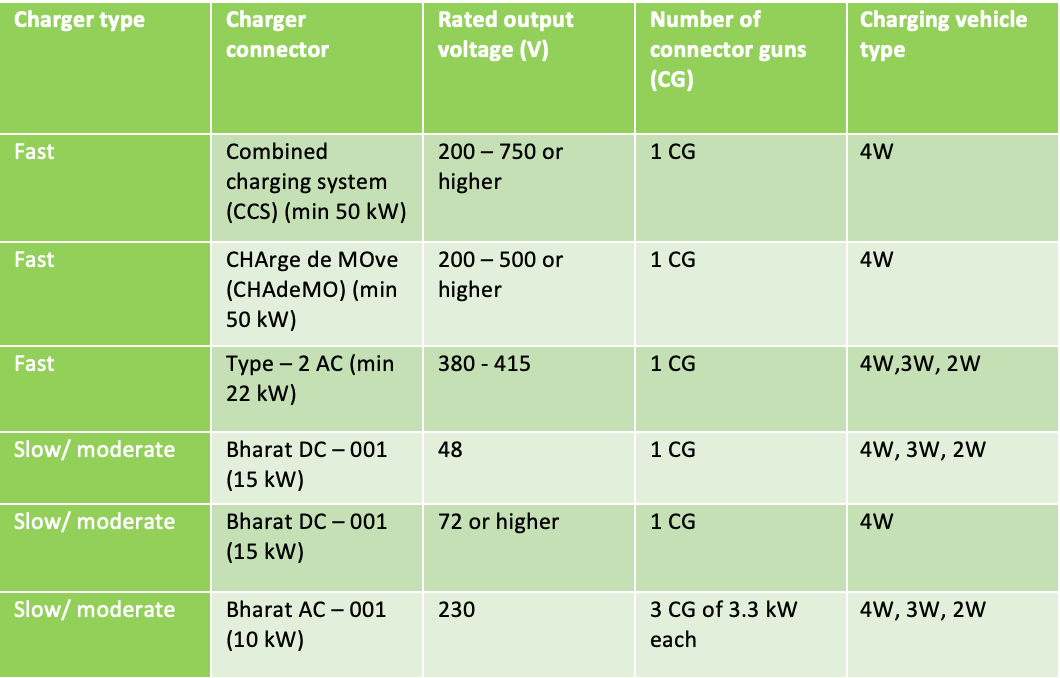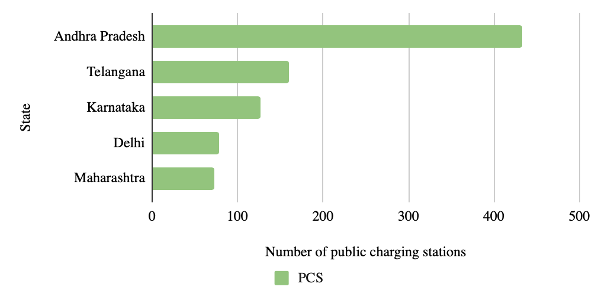Adequate and accessible electric vehicle (EV) charging infrastructure is a necessary precondition for the mass adoption of EVs. To achieve an electric mobility future, governments must focus on building the necessary charging infrastructure – one that supports the target vehicle numbers it hopes to achieve. While there is no perfect EV to charging station ratio to aim for, every country will have to design fit-for-purpose solutions to cater to their electric mobility needs. Accordingly, policymakers will have to formulate targets, standards and financial solutions to accelerate the transition. This transition to electric mobility is governed by both central and state policies in India. Currently, 12 states have EV policies (drafted and approved) while the Faster Adoption and Manufacturing of Electric Vehicles in India (FAME II) scheme operates at the central level.1 This piece assesses whether the state and central government policies are sufficient to build a conducive EV charging network in India.
Countries in an advanced stages in their EV transitions like China and the USA have deployed various strategies to build their charging infrastructure. China has over the years focussed on concrete targets – both vehicular and infrastructural. The Chinese government played a pivotal role in prioritising EVs. In 2015 the state council issued a guidance note that called for charging stations sufficient for 5 million EVs by 2020. The same order mandated that all new residential spaces and 10 per cent of all public parking spaces be reserved for EV charging. Subsequently, the National Development and Reform Commission (NDRC) of China set a target of at least 0.12 million EV charging stations and 4.8 million charging points to be built by 2020. Five national standards for EV charging interfaces and communication protocols were also published in 2016. As per the ‘13th Five Year Plan for New Energy Vehicle Infrastructure Incentive Policies’ of 2016 - USD 13.6 million was provided in funding for this. Residential EV charging received special attention, with over 30 cities offering subsidies for home charging.2 In April 2020, it was decided that China would invest USD 381 million in EV charging to enable the State Grid company to build 78,000 more charging stations over the year.3
Meanwhile in the United States of America (USA), state governments play a much larger role on this front. Federal policies offer support in the form of tax credits on the cost of installing an EV charger or loan guarantees for chargers built along identified charging corridors.4 Local governments offer similar financial incentives. For instance, California offers low-interest loans and Colorado offers business tax credits and grants to purchase charging stations. On the other hand, states like Oregon promote EV charging by fast-tracking applications for residential chargers.5
In India, the government has allotted INR 1,000 crore (approximately USD 135 million) for charging infrastructure under the FAME II policy. Charging stations are to be set up in phases, with the first phase focussing on megacities and national highways and corridors. The subsequent phases will focus on million-plus cities, state capitals, UTs, and smart cities. While the scheme encourages the interlinking of renewable energy, the use of smart grids, etc., it fails to outline specifications for the same. As of now no targets numbers are specified, although the density targets laid out are as follows:
- At least one public charging station in every 3x3 km grid
- One charging station every 25 km on both sides of highways and roads
- One fast charger every 100 km on highways and roads
The Department of Heavy Industries (DHI) sanctioned 2,636 new charging stations across 62 cities and 24 states and UTs in January 2020 under this scheme.6 Maharashtra was allotted the highest number – 317 public charging stations - while Karnataka and Tamil Nadu were allotted 266 and 256 stations respectively. Of the total 2,600 of these are to be allotted to Rajasthan Electronics & Instruments Limited (REIL), Energy Efficiency Services Limited (EESL), Power Grid Corporation, and National Thermal Power Commission (NTPC).7 The Ministry of Heavy Industries and Public Enterprises also sanctioned 241 additional charging stations in September 2020.8 In addition to these, the DHI also invited proposals for the construction of 2,877 EV chargers on highways and expressways in October 2020. Recently, the Ministry of Power announced that it would set up charging infrastructure across 69,000 petrol pumps in India.9
Many Indian states are also complementing these efforts by designing policies to meet their local charging requirements. For instance, in September 2020, the Uttar Pradesh government identified locations for charging station facilities under it’s smart city project. This initiative will be carried out in the eight cities of Lucknow, Varanasi, Prayagraj, Kanpur, Aligarh, Saharanpur, Bareilly, and Jhansi.10 Private companies like Ather, Lithium Urban, Magenta, Okaya, and Tata Power are also expected to scale up their charging station networks over the next few years.
Guidelines and standards for EV charging in India were published by the Ministry of Power in October 2018. The same guidelines delicensed the setting up of public charging stations in India and permitted private charging. Those setting up public charging stations would also be provided with connectivity on a priority basis. Additionally, it has been decided that the Bureau of Energy Efficiency (BEE) will be the central nodal agency to coordinate the rollout of public charging infrastructure, in addition to those decided by individual states.
Table 1: Public charging standards in India

Source: FAME II11
Individual states in India have also prioritised the sector, with 12 states having issued dedicated EV policies. Some states and Union Territories (UTs) like Andhra Pradesh, Bihar, Delhi, Telangana, and Uttar Pradesh have set concrete targets for EV charging infrastructure rollout. The Andhra Pradesh and Uttar Pradesh EV policies have targets of 0.1 and 0.2 million charging stations, respectively, to be built by 2024.12 Bihar and Delhi, on the other hand, specify charging station density targets - Delhi aims to have chargers located every 3 km, whereas Bihar aims to have chargers located at every 50 km on all highways.13
State EV policies primarily rely on capital subsidies to realise these targets. Most states provide a 25 per cent capital subsidy, subject to various conditions such as subsidy ceilings on how many stations may avail of this scheme. For example, Madhya Pradesh provides a 25 per cent capital subsidy on all small charging stations up to an amount of INR 0.15 million for the first 300 chargers.14 Reimbursement of the net state’s goods and services tax (SGST) are provided in states like Andhra Pradesh, Delhi, and Karnataka. Interest free loans are also provided by the Karnataka state government to those setting up charging stations.15 Tamil Nadu provides 100 per cent exemption from electricity tax to charging stations.16 Eleven Indian states, among which are Assam, Delhi, Goa, and Gujarat, provide special EV tariffs for public charging stations as well.17 The Delhi government provides a grant of up to 100 per cent on charging equipment set up by building owners, whereas Uttar Pradesh provides a 25 per cent rebate on of the market rate for land procured for charging points.
Non-financial incentives also play an important role in incentivising the charging ecosystem. States like Bihar, Delhi, Maharashtra, Punjab, and Telangana have issued directives aimed at setting up charging stations in residential and non-residential spaces. Setting up reserved parking spaces and common charging points in petrol pumps and residential and non-residential buildings is commonly encouraged. States like Madhya Pradesh and Telangana encourage the use of renewable energy for EV charging as well.
Table 2: Summary of state EV policies

Source: CEEW-CEF analysis
The public charging database maintained by the Central Electricity Authority (CEA) shows that as of June 2020, there are a total of 933 public charging stations across the country.18 This list shows that Andhra Pradesh, Telangana, and Karnataka have the highest numbers – 433, 160, and 126, respectively.
Figure 1: Top 5 states with highest number of public charging stations

Source: CEEW-CEF analysis based on CEA database
An electric mobility future must have the right charging infrastructure required to support it. While India’s EV policies are providing the right signals, they need to do much more to realise the envisioned transition. The efforts by the government will play a pivotal role in laying the foundation for an electric vehicle based future and increasing the market confidence. Policies must lay down specific targets for course correction and review in the future. Dedicated efforts towards accelerating residential home charging geared towards two wheelers are important too. Lastly, policies must encourage private participation through new business models suited to public charging in India. The government, vehicle manufacturers, and independent charge point operators – all part of this ecosystem, will have to play a very proactive role to mass adoption in the future.
To understand the EV space better, to track it’s many developments, and facilitate more work in this sector, we at the Centre for Energy Finance have developed an Electric Mobility dashboard with a dedicated section on charging infrastructure. It attempts to map all the publicly available charging stations, in the country, with their specific geo-location. Here, you can find your nearest public charging station as well as macro-level insights into the charging industry at large.
Figure 2: Charging station locator

By bringing together all the sectoral trends at one place, we hope to provide users with a complete understanding of India’s mobility transition.
References
- [1] Ministry of Heavy Industries and Public Enterprises, “Scheme for Faster Adoption and Manufacturing of Electric Vehicles in India Phase II (FAME India Phase II).,” 2019.
- [2] Anders Hove and David Sandalow, “Electric Vehicle Charging in China and the United States,” 2019, https://energypolicy.columbia.edu/sites/default/files/file-uploads/EV_ChargingChina-CGEP_Report_Final.pdf.
- [3] Barbara Finamore and Hyoung Mi Kim, “How EV Charging Can Clean Up China’s Electricity Grid,” NRDC, 2020, https://www.nrdc.org/experts/barbara-finamore/how-ev-charging-can-clean-chinas-electricity-grid.
- [4] Christian Roselund, “U.S. Government Makes up to $4.5 Billion in Loan Guarantees Available for EV Infrastructure,” PV Magazine, 2016.
- [5] J.R. DeShazo et al., “State of the States’ Plug-in Electric Vehicle Policies,” 2015, https://innovation.luskin.ucla.edu/sites/default/files/EV_State_Policy.pdf.
- [6] Ministry of Heavy Industries and Public Enterprises, “In Phase-II to Fame India Scheme 2636 EV Charging Stations Sanctioned,” January 3, 2020.
- [7] Sarita C Singh, “REIL, EESL Bag Big Chunk of Orders for EV Charging Stations,” The Economic Times, November 28, 2019, https://economictimes.indiatimes.com/industry/energy/power/reil-eesl-bag-big-chunk-of-orders-for-ev-charging-stations/articleshow/72272020.cms?from=mdr.
- [8] Ministry of Heavy Industries and Public Enterprises, “Expression of Interest Inviting Proposals for Availing Incentives under Fame India Scheme Phase II for Deployment of EV Charging Infrastructure on Highways/Expressways,” 2020.
- [9] PTI, “Government Mulls Installing EV Charging Kiosks at around 69,000 Petrol Pumps in Country,” The Hindu, September 6, 2020, https://www.thehindu.com/news/national/government-mulls-installing-ev-charging-kiosks-at-around-69000-petrol-pumps-in-country/article32534708.ece.
- [10] ETGovernment, “UP Gives Nod for E-Charging Facilities in 8 Cities under the Smart City Projects,” ET Energy World, September 23, 2020, https://energy.economictimes.indiatimes.com/news/power/up-gives-nod-for-e-charging-facilities-in-8-cities-under-the-smart-city-projects/78107402.
- [11] Enterprises, “Scheme for Faster Adoption and Manufacturing of Electric Vehicles in India Phase II (FAME India Phase II).”
- [12] Government of Andhra Pradesh, “Electric Mobility Policy 2018-23,” 2018.
- [13] Government of Delhi, “Delhi Electric Vehicles Policy, 2020,” 2020.d
- [14] Government of Madhya Pradesh, “MADHYA PRADESH ELECTRIC VEHICLE (EV) POLICY 2019,” 2019, http://mpurban.gov.in/Uploaded Document/guidelines/1-MPEVP2019.pdf.
- [15] Government of Karnataka, “Karnataka Electric Vehicle and Storage Policy,” 2017, https://kum.karnataka.gov.in/KUM/PDFS/KEVESPPolicyInsidepagesfinal.pdf.
- [16] Government of Tamil Nadu, “Tamil Nadu Electric Vehicle Policy 2019,” 2019.
- [17] Shyamasis Das and Bhawna Tyagi, “EV- A New Entrant to India’s Electricity Consumer-Basket” (New Delhi, 2020), https://shaktifoundation.in/wp-content/uploads/2020/08/Full-Report-A-New-Entrant-To-Indias-Electricity-Consumer-Basket.pdf.
- [18] Central Electricity Authority, “Details of EVCS/ PCI as on 30th June 2020 under the Jurisdiction of Discoms/ Licensee/ PSUs,” 2020, https://www.cea.nic.in/reports/monthly/ev/2020/ev-06.pdf.



